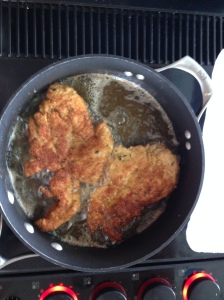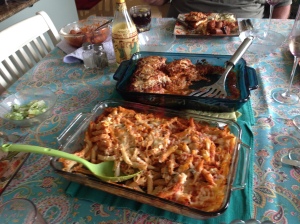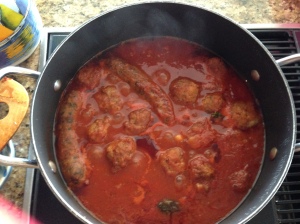I spent 21 years in southern New Mexico, so my cooking was a Tex-Mex-Hatch Valley-chile-inspired marriage. Like my sister, our French-Italian heritage also sometimes shows up. Funny how my Mexican-American friends often asked me to do the cooking! I have included a “slimmed-down” variation, but the richer one is, of course, best. Also, to me, corn tortillas do enchiladas and tacos make. Leave the flour tortillas for burritos, chimis, and fajitas (I happened to read this same belief from the chef/owner at Tallulah’s in Providence, RI). Traditionally, I tend to roll chicken enchiladas and use green chile. I use red chile enchilada sauce with beef fillings and Colby cheddar stacked and layered with corn tortillas, like one would layer lasagna (later post). Red chiles start out green, but turn red if left on the vine longer. These reds can be dried and strung to hang as ristras (very festive during the holidays), readily available to reconstitute when cooking sauces, stews, tamales, and chilis.
Remember, I cook with my senses, so measurements are sometimes approximate.
For a party:
36 corn tortillas
2 cans cream of chicken soup, rinse each can with half can of water or milk and add to the pot
2 cans cheddar cheese soup (I’ve tried the Nacho soup, but this gives it a more watery consistency for some odd reason) rinse each can with half can of water or milk and add to the pot
2 lbs. shredded Monterey Jack &/or Co-jack cheese, &/or pepper jack for more spice
Cooked, shredded chicken** (white meat preferred), about 10-12 oz.
**You can roast, skin shred a chicken or chicken breasts, or buy cooked Southwestern flavored chicken breast strips or deli roaster and cut into bite-sized pieces
1 can evaporated milk (makes your sauce velvety smooth), rinse the can with 1/2 can of water and add to the pot
Milk or half & half to add to your saucepan as needed (you want your sauce rich and creamy, not runny, but not like the consistency of condensed soup)
2 cans chopped green chiles (Yes, in NM in the Fall, we buy fresh Hatch green chiles known as Big Jim’s in 40 lb. batches; we get together to roast and peel and chop them, freezing bags for cooking during the year. I still remember the scent of roasting green chiles from the giant roasters in supermarket parking lots wafting across the valley, but you can roast yours on a grill or in the oven, drop into ice water, and the skins will peel right off.)
1 large sweet onion, finely chopped
Olive Oil (you will have about a 1/4 inch depth of oil in your fry pan; you may substitute any cooking oil, but you will get a different flavor)
fresh garlic, chopped or use garlic powder to taste
1 T. Cumin
1 t. Adobo seasoning con Pimienta o sin pimienta (w/wo pepper)
1 t. dried oregano leaves
When serving a crowd, I tend to keep my dishes mild to medium and serve a spicy pico de gallo or salsa on the side for those who want more heat. This dish requires having your ingredients prepared and ready for creating the “enchilada casserole.”
You will need a large saucepan for your sauce and a frying pan to fry your tortillas. You also need a 13×9 inch baking pan. You can use some of the leftover oil from frying tortillas to grease the sides and bottom of the pan before assembling the enchiladas. Once you are ready to assemble your enchiladas in the baking pan, heat your oven to 375.
Heat a tablespoon of olive oil in the saucepan and add your garlic and spices. Stir in the canned soups, the canned milk, and green chiles. Using a whisk, completely blend your ingredients so there are no clumps of condensed soup. Add half and half or milk as needed if you need to stretch your sauce to cover more, or if you want it a bit thinner. If you want your onions super-cooked, you can saute them in the oil before adding the soups, otherwise you can add them in as you fill and form your rolled enchiladas. Once the sauce is completely heated through, cover and set aside, removing from the hot burner and being careful not to scorch the bottom.
In your frying pan, heat about 1/4 inch layer of oil (olive or other). Have a paper towel-lined platter ready for your fried tortillas. Using tongs, carefully fry corn tortillas on one side until they puff slightly, but don’t let them crisp. Flip them, quickly fry the second side, and remove from the pan to the paper towels. Layer more paper towels if you need to stack your cooked tortillas. They really absorb oil, so drain them well over the pan before moving to the paper towels.
Using a ladle, coat your baking pan with a thin layer of your soup mix/sauce.
Dip a tortilla in the hot soup mixture. Lay in the pan. Using your hands, sprinkle a layer (about a T. of each) of chicken, cheese, and raw onion, if you didn’t cook it into the sauce. Roll tightly, and repeat, laying the rolled enchiladas tightly in the pan, trying not to leave any spaces. You can be as generous as you want with your fillings, depending on how much of the ingredients you have and how fat you want the enchiladas.
If you need to stack another layer, which is good if you want to let these bake, set, and then slice, then add another thin coating of the sauce across the first layer, sprinkle with cheese, and begin your next layer of enchiladas. The last layer will be a generous covering of sauce and cheese.
Bake in a 375 oven for about 30 minutes, or until hot and bubbly, and slightly browned on the top and edges. Do not overcook or they will be dry! Do not undercook, or they will be soupy and the cheese won’t be completely melted.
Remove from the oven and let cool slightly to set. Like lasagna, this step makes it easier to cut into serving squares. Or, you can serve 2-3 rolled enchiladas per person.
Condiments & Accompaniments:
Salsa of preferred “heats”
Pico de gallo (more of a fresh salsa) If making your own salsa, a good rule of thumb on hot/chile peppers is that the smaller and pointer they look, the hotter they taste! Careful not to tough your face or eyes. If you do, flood the area with cold water. If you burn your tongue, don’t drink water; eat bread, or drink milk or pineapple juice.
Sour cream
Chopped iceberg lettuce (this is probably the only time I use iceberg, but it helps to cool the palate and looks pretty)
Chopped tomatoes
chopped raw onion
Some New Mexicans like a fried egg served atop their enchiladas, but we usually do that with red sauce and ground beef filling. Just omit the soups and green chiles, use 2-3 cans red enchilada sauce if not making your own from reconstituted dried red chiles, and fill with sautéed ground beef and Colby cheddar. You can omit the meats altogether for a Lenten or vegetarian version, and you can use refried pinto beans as a filling, but I prefer the beans fried in cumin, garlic and olive oil 🙂 and topped with cheese as a side dish.
To slim down this recipe a bit, steam or soften your tortillas wrapped in paper towels in the microwave instead of frying them. Cut back to one can each of the soups, 2% milk, and add two cans of Old El Paso green enchilada sauce. Use low-fat cheeses. Use portion control 😉
To make a smaller batch, use 1 dozen tortillas, 1 lb. cheese, half the soups — you get the picture.
Enjoy!





